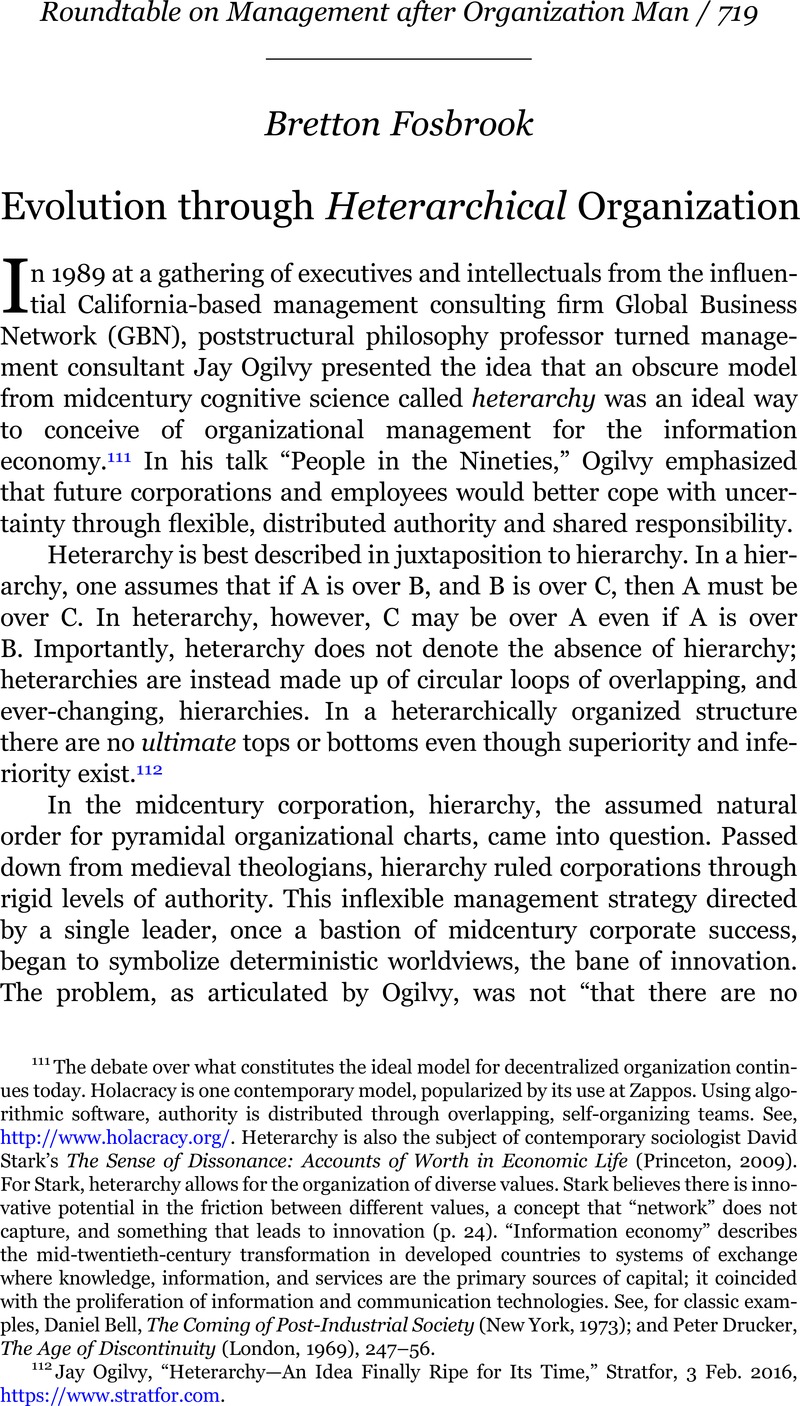Published online by Cambridge University Press: 16 March 2017

111 The debate over what constitutes the ideal model for decentralized organization continues today. Holacracy is one contemporary model, popularized by its use at Zappos. Using algorithmic software, authority is distributed through overlapping, self-organizing teams. See, http://www.holacracy.org/. Heterarchy is also the subject of contemporary sociologist Stark's, David The Sense of Dissonance: Accounts of Worth in Economic Life (Princeton, 2009)Google Scholar. For Stark, heterarchy allows for the organization of diverse values. Stark believes there is innovative potential in the friction between different values, a concept that “network” does not capture, and something that leads to innovation (p. 24). “Information economy” describes the mid-twentieth-century transformation in developed countries to systems of exchange where knowledge, information, and services are the primary sources of capital; it coincided with the proliferation of information and communication technologies. See, for classic examples, Bell, Daniel, The Coming of Post-Industrial Society (New York, 1973)Google Scholar; and Drucker, Peter, The Age of Discontinuity (London, 1969), 247–56CrossRefGoogle Scholar.
112 Jay Ogilvy, “Heterarchy—An Idea Finally Ripe for Its Time,” Stratfor, 3 Feb. 2016, https://www.stratfor.com.
113 Ogilvy, Jay, “The Postmodern Business,” The Deeper News 1, no. 5 (1989)Google Scholar, Stewart Brand Papers, Special Collections, Stanford University [hereafter, SBP].
114 Ibid., 22.
115 Kay, Lily E., “From Logical Neurons to Poetic Embodiment of Mind: Warren S. McCulloch's Project in Neuroscience,” Science in Context 14, no. 4 (2001): 591CrossRefGoogle Scholar.
116 For more on the history of heterarchy, see Fairtlough, Gerard, The Three Ways of Getting Things Done: Hierarchy, Heterarchy and Responsible Autonomy in Organizations (Axminster, U.K., 2007)Google Scholar, 109. On how cybernetics became a universal discipline, see Bowker, Geoffrey, “How to Be Universal: Some Cybernetic Strategies, 1943–70,” Social Studies of Science 23, no. 1 (1993): 107–27CrossRefGoogle Scholar.
117 Orit Halpern writes about the “semiotic character” in her section on McCulloch and rationalization. Halpern, , Beautiful Data: A History of Vision and Reason since 1945 (Durham, N.C., 2015), 156CrossRefGoogle Scholar.
118 On McCulloch's “experimental epistemology,” see Kay, “From Logical Neurons.” On the philosophical and epistemological concerns McCulloch brought to his experimental epistemology, see Abraham, Tara, “Integrating Mind and Brain: Warren S. McCulloch, Cerebral Localization, and Experimental Epistemology,” Endeavor 27, no. 1 (2003): 32–36 CrossRefGoogle Scholar. On Ogilvy's Hegelian inclinations, see Ogilvy, Jay, “Futures Studies and the Human Sciences: The Case for Normative Scenarios,” Futures Research Quarterly 8, no. 2 (1992): 5–65 Google Scholar. Ogilvy's 1969 dissertation—under the supervision of philosopher Paul Weiss, a doctoral student of Alfred North Whitehead's—from Yale University, “Relations,” was a metaphysical tome dedicated to the idea that to be is to be related.
119 Turner, Fred, From Counterculture to Cyberculture: Stewart Brand, the Whole Earth Network, and the Rise of Digital Utopianism (Chicago, 2006), 181CrossRefGoogle Scholar.
120 Ogilvy, Jay, Creating Better Futures: Scenario Planning as a Tool for a Better Tomorrow (Oxford, 2002), xiiiGoogle Scholar.
121 McCulloch, Warren S., Embodiments of Mind (Cambridge, Mass., 1965), 43Google Scholar.
122 Ibid., 44.
123 Stark, Sense of Dissonance, 26.
124 Hayles, N. Katherine, How We Became Posthuman: Virtual Bodies in Cybernetics, Literatures, and Informatics (Chicago, 1999), 80CrossRefGoogle Scholar.
125 This insight was pivotal for Ogilvy: “Running throughout Bateson's essays one finds traces of cybernetic-ecological insight that total conquest over any adversary is a modern and intrinsically self-defeating fantasy. Because the unit of survival is always organism-plus-environment, any significant alteration of the environment is bound to affect the viability of the organization enacting pretensions of control.” Ogilvy, Jay, Many Dimensional Man: Decentralizing Self, Society, and the Sacred (New York, 1977), 359–60Google Scholar. See, e.g., Bateson, Gregory, Steps to an Ecology of Mind (New York, 1972), 438Google Scholar: “We do not live in the sort of universe in which simple linear control is possible. Life is not like that.”
126 Hayles, How We Became Posthuman, 80.
127 Ogilvy, Many Dimensional Man, 8.
128 McCulloch, Embodiments of Mind, 397, quoted in Ogilvy, Creating Better Futures, 146.
129 This sentiment is expressed best by Ogilvy: “The lack of a single and universal hierarchy of values does not entail our taking to the streets with bludgeons.” Ogilvy, Many Dimensional Man, 118.
130 Ibid., 7–8.
131 This is similar to Turner's assessment of GBN. See Turner, From Counterculture to Cyberculture, 181.
132 Ogilvy, Creating Better Futures, viii–ix; Schwartz, Peter and Ogilvy, Jay, “The Emergent Paradigm: Changing Patterns of Thought and Belief,” Values and Lifestyles Report, no. 7 (Menlo Park, Calif., 1979), 13, SBPGoogle Scholar.
133 Schwartz and Ogilvy, “The Emergent Paradigm,” 13.
134 Fairtlough, Getting Things Done, 109.
135 Esalen Institute, “Esalen's Half-Century of Pioneering Cultural Initiatives, 1962–2012,” Center for Theory and Research and Special Projects, Esalen Institute, Sausalito, California, 2012, http://www.esalen.org/sites/default/files/resource_attachments/Esalen-CTR-Pioneering-Cultural-Initiatives.pdf.
136 Michael, Don, “Neither Hierarchy nor Anarchy: Notes on Norms for Governance in a Systemic World,” in Rethinking Liberalism, ed. Anderson, W. T. (New York, 1983), 82Google Scholar.
137 Ibid.
138 Esalen Institute, “Esalen's Half-Century.” Ultimately, the Esalen Group abandoned the term—when a participant looked it up in the Oxford English Dictionary and discovered that it meant to “rule by aliens.” Ogilvy, “Heterarchy.”
139 Ogilvy, Creating Better Futures, 58.
140 Bowker, “How to Be Universal,” 108.